One hundred years ago today, on January 25, 1924, the first Winter Olympics opened in Chamonix, France. Although the International Olympic Committee had decided to hold a winter sports week when Paris was awarded the Summer Games at its meetings in Lausanne, Switzerland, in June of 1921, and the French Olympic Committee confirmed the events in June of 1922, the competition was originally known as the “International Winter Sports Week” — even though it actually stretched for 12 days until February 5, 1924. It was retroactively confirmed as the first Olympic Winter Games at the IOC congress in Prague in May of 1925.
I’ve written several stories over the years about hockey at the Olympics, including the 1924 gold medal victory of the Toronto Granites, the 1920 victory by the Winnipeg Falcons, and the 1928 win by the Toronto Varsity Grads. But this is a story about the 1924 U.S. Olympic hockey team — the silver medalists behind Canada — and one member of the team in particular: Clarence John “Taffy” Abel. The nickname, apparently, comes from his childhood love of the sticky candy.
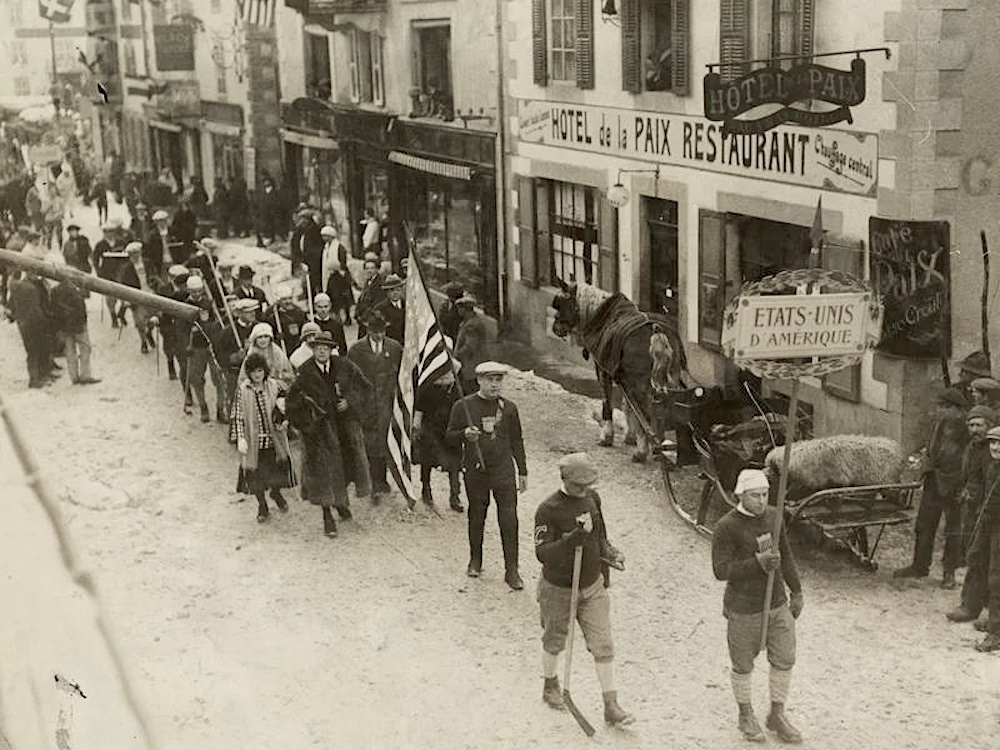
ahead of the small delegation of American athletes. (All photos
are courtesy of George Jones and used with his permission.)
Some of you reading this will recognize Abel’s name.
Some will even know the story.
But many won’t.
So, here we go.
I believe the first time I ever heard the name Taffy Abel was from Alex Levinsky. Levinsky was one of the first Jewish players in the NHL during the 1930s and a relative by marriage of the former wife of a cousin of mine. I met him at a handful of large family gatherings in the late 1980s. Back then, I didn’t know nearly as much about hockey history as I do now (and I’d never heard of Levinsky) but it was always fascinating to talk with him. He was a defenseman — as was Abel — and I remember him telling me once how difficult it was for any NHL forwards to get past Abel and his New York Rangers defense partner Ching Johnson … particularly in the days before forward passing was allowed in the offensive zone. Howie Morenz, the top NHL forward of this era, stood only 5’9″ and weighed just 165 pounds, and even other forwards who were as tall as 5’11” rarely weighed more than 180. Ching Johnson was 5’11” and 210 pounds, while Taffy Abel stood 6’1″ and weighed 225 pounds. Together, they formed a formidable barrier!
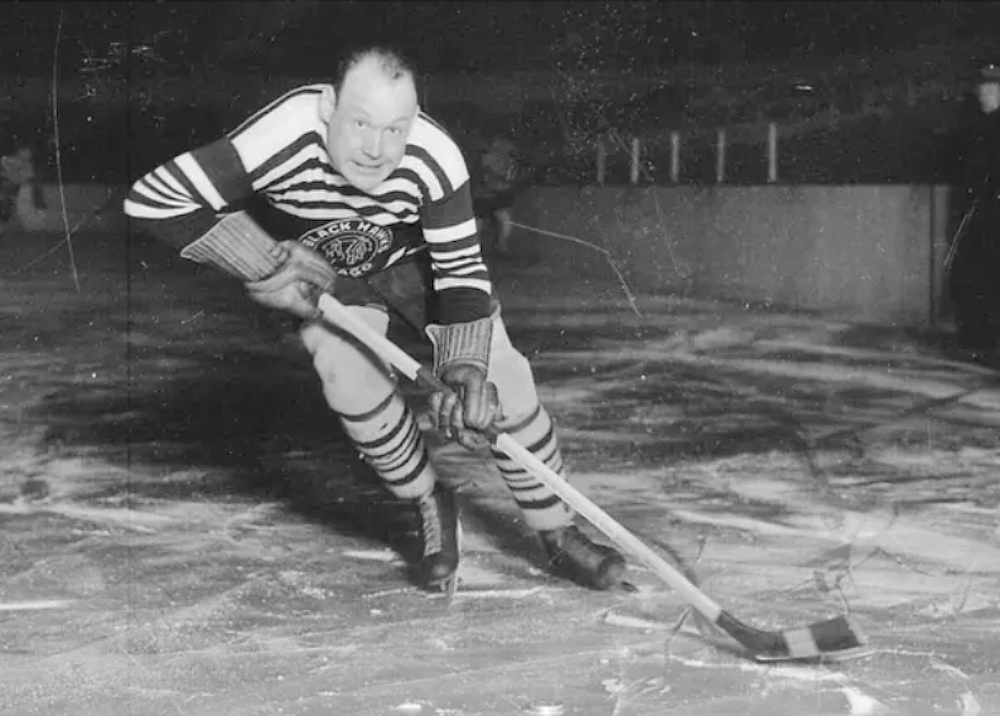
Levinsky faced his share of prejudice as a Jewish player in the NHL in the 1930s. Much of what’s reported is just the sort of casual racism that was typical of the time. I’m sure he encountered plenty of worse things that didn’t make the newspapers given that his Jewish background was well known. But nobody knew Taffy Abel’s true story. Born on May 28, 1900, in Sault Ste. Marie, Michigan, Abel was actually Native American — a Chippewa — who spent most of his life passing for white, which he began to do as a young boy in order to avoid being sent to an Indian boarding school.
Taffy Abel died in 1964, but in recent years, George Jones, a nephew, has been trying to get the NHL to officially recognize Abel’s role in breaking the NHL colour barrier when he first joined the Rangers in 1926. It has proven to be an uphill battle. Other, later, players of colour — Larry Kwong, who was Chinese, Fred Sasakamoose, who was Indigenous, and Willie O’Ree, who was Black — had no way to hide their racial features. But Abel — though apparently listed as Chippewa, along with his mother and sister, in the 1908 “Durant Roll” (a basic census count of Native Americans named for an agent of the Bureau of Indian Affairs) — was able to pass for white. So, nobody knew the truth at the time.
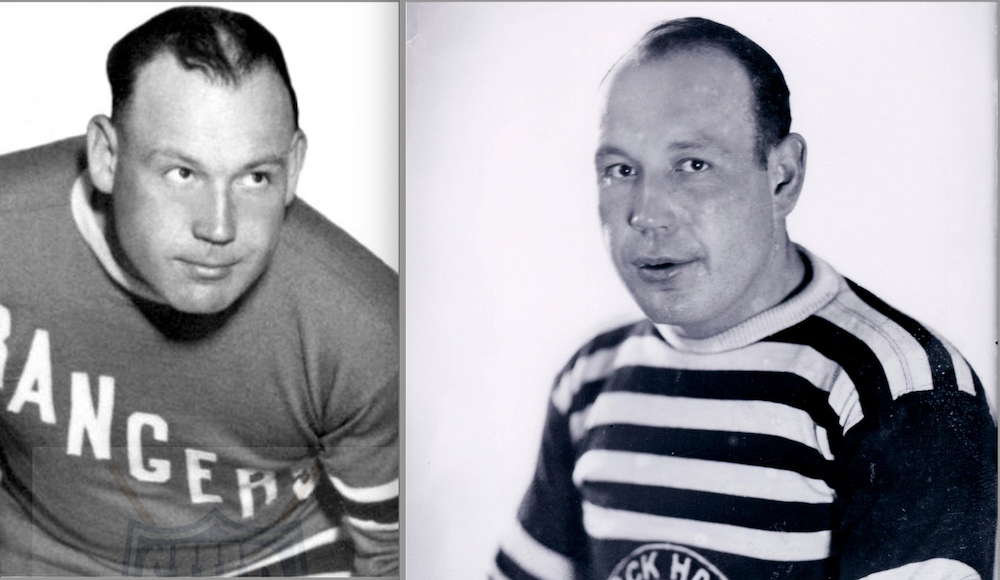
(To me, his features look somewhat more Indigenous in the Chicago picture, but it’s easy to see how he could pass for White.)
According to Jones, Abel didn’t announce his Native heritage until the death of his mother in 1939, which was five years after his NHL career ended. With support from the Sault Ste. Marie Band of Chippewa Indians, Abel was inducted posthumously into the American Indian Athletic Hall of Fame in 1989. He was later among those the National Museum of the American Indian honoured in a roster featured in its 2012 “Native Olympians” exhibition. Several Native Americans — including Jim Thorpe — had competed at the Stockholm Olympics in the summer of 1912, and Taffy Abel is now considered the first Native American Winter Olympic athlete … although — as with his NHL career — nobody knew that in 1924, when he was a late addition to the U.S. team.
A charter member of the United States Hockey Hall of Fame in 1973, Abel’s biography on their website says he began to play hockey in 1918. He likely started earlier than that. The website of the Society for International Hockey Research begins tracking him with a Michigan Soo team during the winter of 1917–18. After four more seasons in his hometown, Abel moved on to the powerhouse St. Paul Saints of the United States Amateur Hockey Association in 1922–23. He was with that team again to start the 1923–24 season before being added to the U.S. Olympic team.
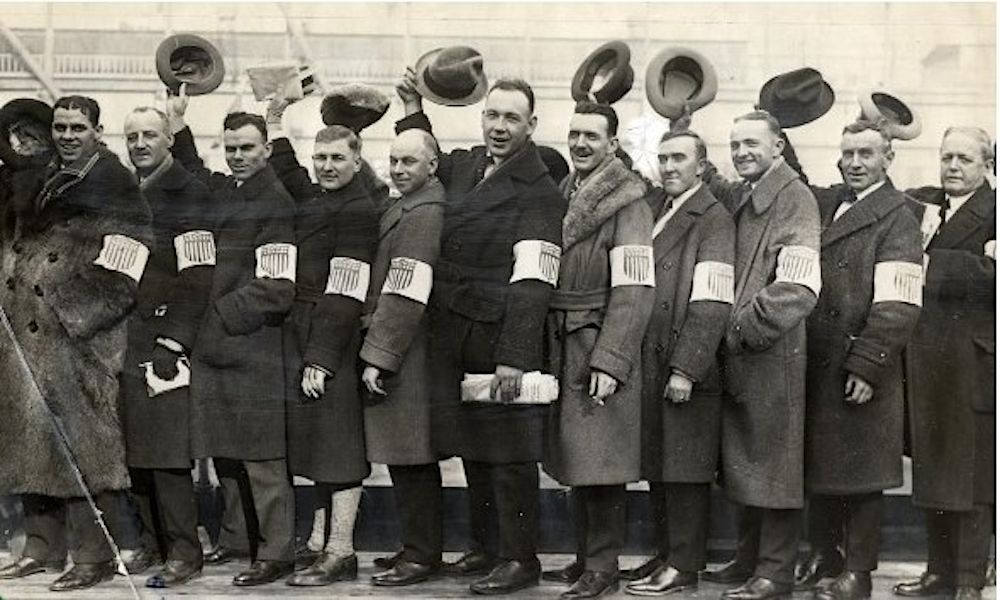
The American team departed for Europe from New York on January 9, 1924, and Abel wrote about the voyage in a letter to Charles Bye of Sault Ste. Marie. The letter was dated January 19, after arrival in Cherbourg, France, and appeared in the local Evening News on February 2. Abel writes of a rough passage after hitting a storm four days out from New York. “[W]e managed to come out of it all right except for missing a few meals,” he said. “It was five days before we finally came out of the gale. I was sure glad when we landed.”
By the time the story was printed, the U.S. hockey team had already scored a 19–0 win over Belgium, a 22–0 win over France, an 11–0 win over Great Britain, and then defeated Sweden 20–0 on February 1 to advance to the gold medal game on February 3. Abel had written before the competition started that it looked like a certainty that the United States would meet Canada in the final (Canada put up even more lopsided wins en route to the big game), but that the Americans would need to improve their teamwork from the few games they had played together in Boston before leaving for France. “If we play that way against Canada,” Abel worried, “they will need an adding machine to keep track of their scores.”
Still, Abel promised better things. “If the forward line will give [goalie Al “Frenchy”] LaCroix, [defense partner Irv] Small and myself just one goal to work on, we swear we will eat the puck before we let them score.”
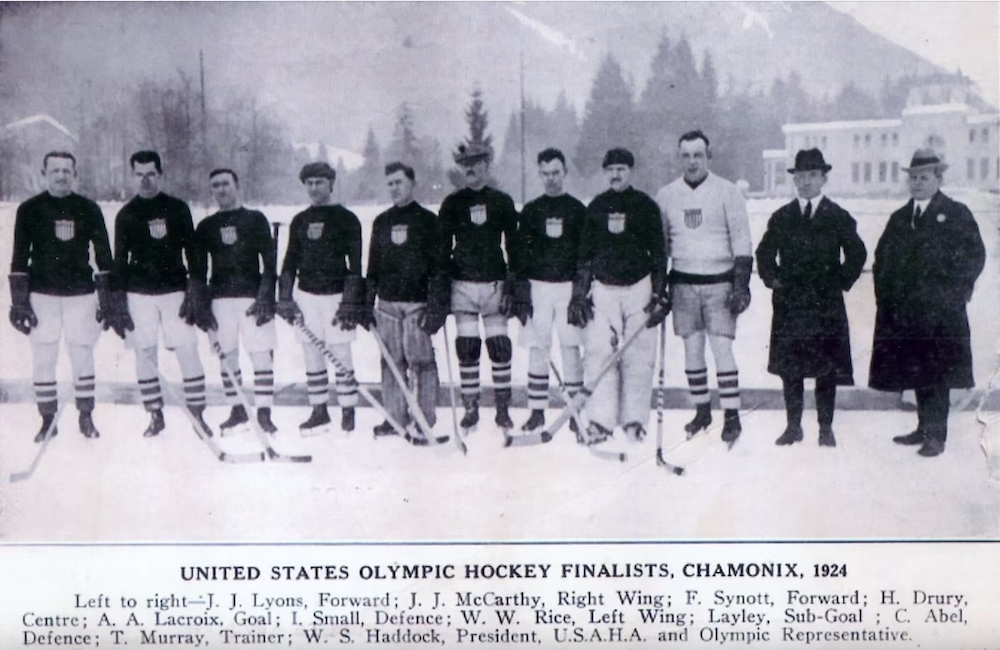
The Americans did get one goal … but Canada scored six to win the gold medal. According to a story in the Pittsburgh Gazette Times on February 22, 1924, Abel believe the best team won that day, although he was convinced the Americans could have been better. “The Granites beat us on the merits of the teams as they lined up,” said Abel, “but I’ll never be satisfied that they could not be beaten if America had sent over its best available hockey team. They were too strong for us as things were in France, but if the best possible team had been picked and the best possible men had gone over, after having had plenty of practice, America would have won.”
Taffy Abel would never have another chance to win Olympic gold. He later won the Stanley Cup with the New York Rangers in 1928 and again with the Chicago Blackhawks in 1934. Metis players Tony Gingras and brothers Magnus and Rod Flett won the Stanley Cup with the Winnipeg Victorias in 1901 and 1902. Abel is the first Native American to have won the Cup, and the first to do so with an NHL team … but the complicated legacy of early Indigenous players has made such feats difficult to track.
As George Jones told Stephen Whyno of the Associate Press for a story about Abel in December of 2022: “The reason he had to pass was not one of choice — it was one of survival. I’m proud of him, what he did — very proud. I know what he had to go through and the internal torment that he had to go through as part of this ‘passing’ thing. He had depression, he had drinking problems, but he survived.”